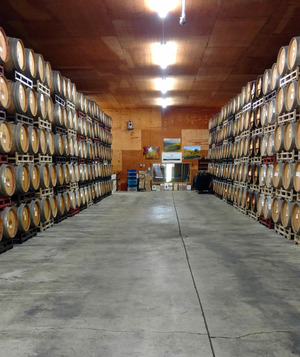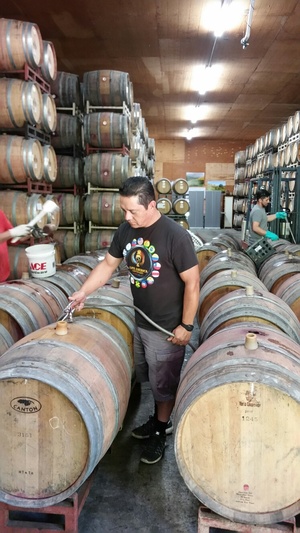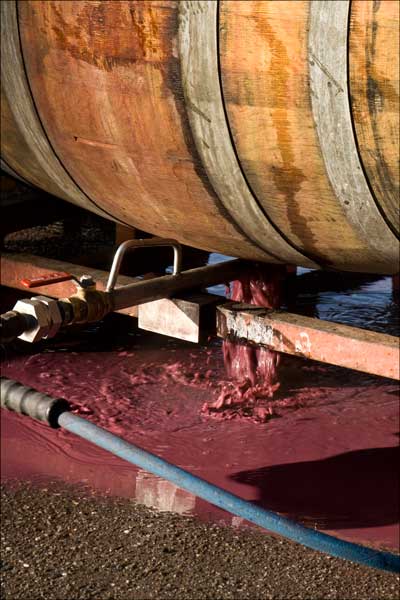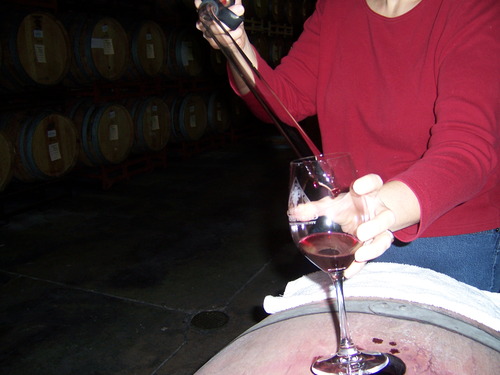barrels
-
The Importance of Aging
February 16, 2021 14:37

In this post we take a closer look at the barrel room and what goes on during the year. If you have visited our tasting room you would see we have a window looking into the process-at different times of the year the view is of the cellar crew taking down each and every barrel about every three months-whether it is to empty them out of the previous vintage, top them off or fill them up with the latest harvest.
Barrels at Rest
Quietly aging away, these barrels are at rest. Incremental changes happen over the cellar year. There is quite a bit of work that goes into ensuring each barrel is checked several times throughout the aging process. We have up to 2000 barrels at any given time during the year either being filled or being emptied of their contents.

 Barrel Vocabulary
Barrel VocabularyThere are some fancy words in the world of wine, some of them borrowed from the French winemaking tradition: Bâtonnage, Ullage, Sur Lie. In this photo of cellarmaster Polo Cano and his crew you’ll see them in action as I describe some of these terms:
We use the word ullage to describe the loss of wine due to evaporation while the wine ages in barrel or bottle. In a bottle you can see the fill line (or ullage) and if there has been too much loss over time then the wine may have had too much oxygen and, in some cases the wine might be bad. The same happens in the barrel but to a larger degree-larger container more loss, meaning a gallon or three over the year. This is often referred to as the angel’s share-the portion evaporating away while slowly oxygenating the wine. This concentration of barrel contents brings a slow softening of the raw red wine. In the case of barrels they are topped up 3 times in the course of their year in barrel and this maintains quality with no spoilage.
Bâtonnage is the stirring of the barrel. Each time the barrels are taken down for topping the barrels are stirred with a long baton, incorporating the lees and enriching the wine. Sur Lie means the wine in the barrel is aged with the ‘lees’ or dregs, if you will. It is made up of the dead yeast cells and perhaps bits of skin and seeds-small bits. When a wine is aged ‘sur lie’ it is all the better for it, adding flavor components, texture and bouquet. As the wine makes it way to bottling the lees are left behind, having done their job.
In the photo below you’ll see a barrel being emptied of the lees.
Thieving
The act of ‘thieving’ wine and tasting young wine is an educational process. Using a wine thief, checking on the progress a few times during the year as it matures gives the winemaker a window into how the wine is progressing-does it need more time? Less? The wine thief itself, pictured above, is nothing more than a glass tube for syphoning out a small sample of the wine. If you are trying a wine from the recent harvest be prepared-the tannins are pretty harsh but the silver lining is you get a glimpse of things to come—the fruit components, the acidity, the body—and some of the characteristics will dominate the others. It boils down to a matter of time and winemakers are a patient lot. This equals a nicely aged wine ready to be bottled with many of the rough edges seasoned by time and the barrel itself.

-
Staving Time
February 1, 2021 14:36

Just like vineyards there are seasons in the cellar too. Barrels are the focus of wintertime. Harvest begins the cycle each year and a couple of months later the process begins. Barrels are emptied of the previous vintage and makes room for the new one, typically called barreling down. Let’s take a look at what aging does to wine.
Why do we barrel age wine at all? Think about it in this way. If you have a raw piece of wood that needs the edge taken off and you’d like to use it as a frame, you’d start sanding and shaping it. The same thing happens in barrel-the wine is raw and rough when it is transferred. Aging for an average of one year helps to smooth out those rough edges and provides the framing of flavor and body.
This is a part of a wine’s journey where it seems like there isn’t anything going on but you and I know there is. Oxygenation is the process and takes time to slowly change the wine from its’ youthful and raw exuberance to a more refined and drinkable one. The barrel itself isn’t airtight and allows a very small amount of oxygen in to soften the wine. And it exhales too-sometimes referred to as the ‘angel’s share’ and why the cellar and barrel room smell so wonderful, the bouquet of wine in its’ many states. Another benefit is concentration. With evaporation of water and even alcohol you get concentrated flavors, enhancing the fruit profile of the wine.
Each barrel is taken down three times during the course of aging to replace the wine lost to oxygenation thereby preventing any possible spoilage-this is called topping the barrels. The photo I included above features this process and our Cellarmaster Polo Cano knows each barrel and wine like the back of his hand. The time spent in oak not only slowly ages the wine it also steeps in the oak, which imparts the element of toast, vanilla and nut aromas often detected in the bouquet of barrel aged wines. This adds another level of complexity and plays an important role in quality, aroma and taste of the finished wine. Our winemaking style calls for 25 to 30% new oak blended with seasoned barrels. This helps us keep a balance between the fruit and the oak components for a ‘just right’ taste in your glass. The give and take during the aging process from the first moment in barrel to the last as the wine is prepared for bottling provides a canvas for the variety. Some of our wines are aged less than a year (Pinot Noir and Sonoma Classico) and others like our Wisdom Cabernet Sauvignon spend nearly two years. It is determining what is best for the grape that makes these wines so well crafted.
Categories
- COVID
- Follow the Vineyard
- Note from Home
- PairItWithPed
- Pandemic
- pedroncelli
- Port
- Postcards from Home
- Pruning
- Seasons in The Cellar
- Tasting Room
- Thanksgiving
- Vintage Notes
- Winemaking
- Women's History Month
Recent posts
-
91 Years Later
-
Come Over October: It's About Community
-
Come Over October
-
A Legacy Continues!
-
Everything Old is New Again
Popular tags
- COVID19
- Lake Sonoma
- cooking with wine
- Habit
- American Oak
- food and wine
- Merlot
- newsletter
- Library Wine
- Seasons in The Cellar
- Crop set
- Heat wave
- Follow the Vineyard
- Down to Earth
- OpenThatBottleNight
- 1974 Cabernet Sauvignon
- Courage Zinfandel
- Easter
- Pedroncelli
- Pruning
- Cabernet Sauvignon
- Anniversary
- Barrels
- Homecooking
- Cellar Master
- Bushnell Vineyard
- Harvest 2022
- Recipes
- cheese
- COVID Coffee Chat
- Sauvignon Blanc
- Schotzki
- Estate Vineyard
- Mother Clone
- Sonoma County
- Cookies
- Four Grapes Port
- PairitwithPed
- Pandemic
- Rosé
- Finding Your Roots
- Pantry
- Block 007 Cabernet Sauvignon
- Oak
- French Oak
- Dry Creek Valley
- note from home
- family
- Reserve
- Holding steady





